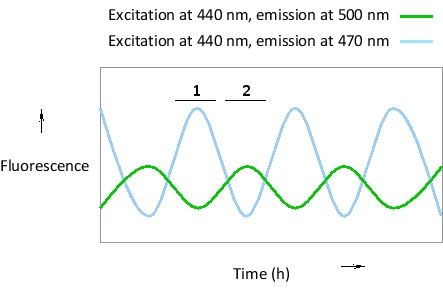Question 19
(Short Answer)
Imagine a transcription regulatory protein (X) that is known to shuttle back and forth between nucleus and cytosol in an oscillatory pattern. Protein Y is a nuclear protein that can bind to X to create a dimer that binds to DNA. You have fused protein X to green fluorescent protein (GFP) and protein Y to blue fluorescent protein (BFP), and have measured fluorescence resonance energy transfer (FRET) and non-FRET signals in the nucleus at different time points, as indicated in the following simplified plot. At which time period (1 or 2) do you think protein X is in the nucleus? BFP can be excited at 440 nm, and emits maximally at 470 nm. GFP is excited at 470 nm and emits maximally at 500 nm.

Answer
The FRET signal in the green ...
View full Answer